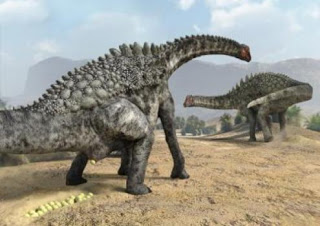
Mar. 12, 2013 — A study headed by the Miquel Crusafont Catalan Palaeontology Institute has for the first time documented detailed records of dinosaur egg fossils in the Coll de Nargó archaeological site in Lleida, Spain. Up until now, only one type of dinosaur egg had been documented in the region.
The archaeological site in Coll de Nargó containing dinosaur eggs lies some 8 kilometres to the west of the town that bears the same name in the province of Lleida. This region is home to different types of geological formations, including the Areniscas de Arén Formation and the Tremp Formation, which have provided a rich and varied yield of dinosaur fossils through the entire Pyrenees region.
“Eggshells, eggs and nests were found in abundance and they all belong to dinosaurs, sauropods in particular. Up until now, only one type of dinosaur egg had been documented in the region: Megaloolithus siruguei. After analysing more than 25 stratus throughout the Tremp Formation, a minimum of four different additional types were identified: Cairanoolithus roussetensis, Megaloolithus aureliensis, Megaloolithus siruguei and Megaloolithus baghensis,” as explained by Albert García Sellés from the Miquel Crusafont Catalan Palaeontology Institute and lead author of the study.
One of the main problems faced by palaeontologists when studying fossil remains is determining the age of the sediments that contain them. There are fossils known as “guide fossils” whose characteristics allow for the age of rocks to be deduced. However, these fossils are frequent in marine sediments but more scarce and difficult to find in land sediments.
“It has come to light that the different types of eggs (oospecies) are located at very specific time intervals. This allows us to create biochronological scales with a precise dating capacity. In short, thanks to the collection of oospecies found in Coll de Nargó we have been able to determine the age of the site at between 71 and 67 million years,” ensures the expert.
The paleontological sites in the south of Europe containing dinosaur remains have a high scientific value since they allow us to understand and thus reconstruct the ecosystems at the end of the Mesozoic Era.
The latest scientific investigations show that the dinosaur fauna of the European Continent living for a short time before the great extinction some 66 million years ago can be found exactly on the southern side of the Pyrenees.
A connection between French and Spanish dinosaurs
“We had never found so many nests in the one area before. In addition, the presence of various oospecies at the same level suggests that different types of dinosaurs shared the same nesting area,” concludes the scientist.
Note : The above story is reprinted from materials provided by FECYT – Spanish Foundation for Science and Technology, via EurekAlert!, a service of AAAS.










